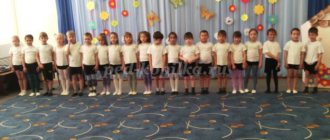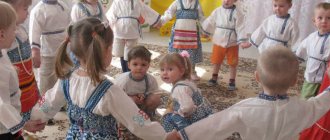“Card index of outdoor games” senior group
Card index of outdoor games
Senior group
- Carousel
Purpose of the game: to develop in children the rhythm of movements and the ability to coordinate them with words. Practice running, walking in a circle and forming a circle.
Progress of the game:
The players form a circle. The teacher gives the children a cord, the ends of which are tied. The children, holding the cord with their right hand, turn to the left and say the poem: “Barely, barely, barely, barely, the carousel started spinning. And then around, around, all running, running, running.” In accordance with the text of the poem, the children walk in a circle, first slowly, then faster, then run. While running, the teacher says: “It’s okay.” Children run in a circle 2 times, the teacher changes the direction of movement, saying: “Turn.” The players turn in a circle, quickly grabbing the cord with their left hand and run in the other direction. Then the teacher continues with the children: “Hush, hush, don’t write it off, stop the carousel. One, two, one, two, the game is over!” The movements of the carousel are becoming slower and slower. At the words “the game is over,” the children lower the cord to the ground and disperse.
Rules: You can take a place on the carousel only by calling. Those who do not manage to take a place before the third bell do not take part in the skating. You must make movements according to the text, observing the rhythm.
- Mousetrap
Purpose of the game: to develop children's self-control, the ability to coordinate movements with words, and dexterity. Practice running and squatting, lining up in a circle and walking in a circle. Promote speech development.
Progress of the game:
The players are divided into two unequal groups. The smaller one forms a circle - a “mouse trap”, the rest of the “mice” - they are outside the circle. The players, depicting a mousetrap, hold hands and begin to walk in a circle, saying: “Oh, how tired the mice are, they gnawed everything, ate everything. Beware, you cheaters, we will get to you. We’ll set mousetraps for you and catch everyone now.” Children stop and raise their clasped hands up, forming a gate. Mice run in and out of the mousetrap. According to the teacher: “clap”, the children standing in a circle lower their hands and squat - the mousetrap has slammed shut. Players who do not have time to run out of the circle are considered caught. Caught mice move into a circle and increase the size of the mousetrap. When most of the mice are caught, the children change roles.
Rules: Lower your clasped hands at the word “clap.” After the mousetrap has slammed shut, you must not crawl under your arms.
- We are funny guys
Purpose of the game: to develop in children the ability to perform movements according to a verbal signal. Practice running in a certain direction while dodging. Promote speech development.
Progress of the game:
Children stand on one side of the playground. A line is drawn in front of them. A line is also drawn on the opposite side. On the side of the children, in the middle, between the two lines, there is a trap assigned by the teacher. The children say in unison: “We are cheerful guys, we love to run and jump, well, try to catch up with us. One, two, three, catch!”
After the word “catch,” the children run to the other side of the playground, and the catch catches up with those running. The one who is touched by the trap before the player crosses the line is considered caught and sits down near the trap. After 2-3 runs, the caught ones are recounted and a new trap is selected. Rules: You can only cross to the other side after the word “catch”. The one touched by the trap moves aside. The one who crossed to the other side, beyond the line, cannot be caught.
- The herd and the wolf
Purpose of the game: develop the ability to perform movements on a signal, practice walking and running quickly.
Progress of the game:
On one side of the site, circles and squares are outlined. These are buildings: a calf barn, a stable. The rest is occupied by “meadow”. In one of the corners on the opposite side there is a “wolf’s lair” (in a circle). The teacher appoints one of the players as a “shepherd”, the other as a “wolf”, who is in the den. The rest of the children depict horses and calves, which are in the barnyard, in the appropriate rooms. At a sign from the teacher, the “shepherd” takes turns approaching the “doors” of the calf barn and stables and, as it were, opens them. Playing the pipe, he leads the whole herd out into the meadow. He himself walks behind. The players, imitating domestic animals, nibble grass, run, move from one place to another, approaching the wolf’s lair. “Wolf,” says the teacher, everyone runs to the shepherd and stands behind him. Those who did not manage to reach the shepherd are caught by the wolf and taken to the lair. The shepherd takes the flock to the barnyard, where everyone is placed in their places.
Rules: The wolf runs out of the lair only after the word “wolf”. At the same time as the wolf runs out, all players must run to the shepherd. Those who do not have time to stand behind the shepherd are taken away by the wolf.
- Swan geese
Purpose of the game: to develop children's self-control and ability to perform movements when given a signal. Practice running while dodging. Promote speech development.
Progress of the game:
At one end of the site a line is drawn - “house”, where the geese are located; at the opposite end there is a shepherd. To the side of the house is the “wolf’s lair.” The rest of the place is “meadow”. The teacher appoints one as a shepherd, another as a wolf, the rest pretend to be geese. The shepherd drives the geese out to graze in the meadow. Geese walk and fly across the meadow. The shepherd calls them “Geese, geese.” The geese answer: “Ga-ga-ha.” “Do you want to eat?” "Yes Yes Yes". “So fly.” "We are not allowed. The gray wolf is under the mountain and won’t let us go home.” “So fly as you want, just take care of your wings.”
The geese, spreading their wings, fly home through the meadow, and the wolf runs out, blocks their path, trying to catch as many geese as possible (touch with hand). The wolf takes the caught geese home. After 3-4 runs, the number of those caught is counted, then a new wolf and shepherd are appointed.
Rules: Geese can fly home, and the wolf can catch them only after the words “So fly as you want, just take care of your wings.” The wolf can catch geese in the meadow up to the border of the house.
Options: Increase distance. Introduce the second wolf. There is an obstacle on the wolf's path - a ditch that must be jumped over.
- Who will take off the tape first?
Purpose of the game: to develop children's self-control and ability to act on a signal. Children practice fast running and jumping.
Progress of the game:
A line is drawn on the playground, beyond which children line up in several columns of 4-5 people. At a distance of 10-15 steps, opposite the columns, a rope is stretched, the height is 15 cm above the children’s raised hands. A ribbon is placed on this rope against each column. At the signal “run,” everyone standing first in the columns runs to their ribbon, jumps up and pulls it off the rope. The first person to remove the tape is considered the winner. The ribbons are hung up again, those who were first in the column stand at the end, and the rest move towards the line. At the signal, the next children run. Etc. The winnings in each column are counted. Rules: You can only run after the word “run”. Pull the tape only in front of your column.
- Frogs and heron
Purpose of the game: to teach children to jump in place from a deep squat, jump over a rope located at a height of 15 cm, in different ways: with two legs, with one, from a run, trying not to be caught by a heron. Develop agility and speed of movement.
Progress of the game:
A swamp is marked in the middle of the site, pegs are driven in with a height of -15 cm. They hang a rope with weights on them so that it does not sag. To the side of the swamp is a heron. Frogs jump in the swamp, catching mosquitoes. At the signal “Heron!” -she steps over the rope and begins to catch frogs. They can jump out of the swamp in any way: pushing off with two legs, one leg, or running. The caught frogs go to the heron's nest.
Anyone who steps over the rope is considered caught; you can only jump over.
8. Don't stay on the ground
Purpose of the game: we teach children to run quickly in different directions without bumping into each other, to climb onto a hill - a stump, a log, etc. We develop dexterity and speed in movements.
Progress of the game:
A driver is selected who runs with all the children.
As soon as the teacher says: “Catch!”, everyone runs away from the driver and tries to climb onto a hill - a log, a stump, etc. If the driver manages to catch someone, he is considered caught and moves aside. At the end of the game, the number of losers is counted and another driver is selected from among those who were not caught.
9. Get to your places quickly
Purpose of the game: to develop orientation in space, the ability to perform movements according to a signal. Practice fast running, walking, jumping.
Progress of the game:
Children stand in a circle at arm's length, each person's place is marked with an object. At the word “run”, children leave the circle, walk, run or jump across the entire playground. The teacher removes one item. After the words “take your seats,” all children run in a circle and take empty seats. To the one who remained, the children said in unison, “Vanya, Vanya, don’t yawn, quickly take your place!”
Rules: A place in the circle can only be taken after the words “Take your places.” You can’t stay still after the word “run.”
- Trap, take the tape
Purpose of the game: to develop dexterity and intelligence in children, to practice running with dodging, catching and lining up in a circle.
Progress of the game:
The players line up in a circle, each receives a ribbon, which he places behind his belt or behind his collar. There is a trap in the center of the circle. At the signal “run,” the children run away, and the trap tries to pull out a ribbon from someone. The one who has lost his ribbon moves aside. At the signal “One, two, three, quickly run into a circle,” the children line up in a circle. The catcher counts the number of ribbons and returns them to the children. The game starts with a new trap.
Rules: The catcher must take only the tape, without delaying the player. The player who has lost his ribbon steps aside.
- Fishing rod
Purpose of the game: teach children to jump in place on two legs over a rope, cord, or skipping rope. We develop dexterity, attentiveness, and speed in movements.
Progress of the game:
The players stand in a circle, with the driver in the center. He holds a rope in his hands, at the end of which a bag of sand is tied. The teacher rotates the rope with the bag in a circle above the ground (floor), and the children jump up on two legs, trying to prevent the bag from touching their legs. Having described 2-3 circles with the bag, the teacher pauses, during which the number of children whose legs were touched by the bag is counted and the necessary instructions are given for performing jumps. The game is repeated 3-4 times.
- Astronauts
Purpose of the game: we teach children to move quickly around the playground, without touching each other, and to take their places on time.
Purpose of the game:
Rockets are drawn on the floor (ground), in which there are 4-5 circles - these are the places of the astronauts. Children walk around the playground (hall) in a circle, saying:
Fast rockets are waiting for us
For walks on the planets.
We’ll fly whichever one we want.
But there is one secret in the game: there is no room for latecomers!
With the end of the words, the children scatter around the rocket launch site, and everyone tries to take a place in any of the rockets. There are two or three fewer seats in rockets than there are astronauts. Those who are late are considered losers. The game repeats itself.
- Owl
Purpose of the game: development of attention, reaction to verbal commands and voluntary regulation of behavior.
Progress of the game:
An owl's nest is marked on the site. The rest are mice, bugs, butterflies. At the signal “Day!” - everyone is walking and running. After a while the signal “Night!” sounds. and everyone freezes, remaining in the position in which the team found them. The owl wakes up, flies out of the nest and takes the one who moves to its nest.
- Homeless hare
Purpose of the game: exercise of short-term fast running, development of reaction to quick decision-making.
Progress of the game:
From among the players, a “hunter” and a “stray hare” are selected. The rest of the children - hares - are located in houses (circles drawn on the ground). A homeless hare runs away from a hunter. A hare can escape by running into someone’s house, but then the hare standing in the circle becomes a homeless hare and must run away immediately. After 2-3 minutes, the teacher changes the hunter.
- Sly Fox
Purpose of the game: to develop children's endurance and observation skills. Practice running quickly with dodging, lining up in a circle, and catching.
Progress of the game:
The players stand in a circle at a distance of one step from each other. The fox's house is outlined outside the circle. The teacher invites the players to close their eyes, walks around the circle behind the children and says, “I’m going to look for a cunning and red fox in the forest!”, touches one of the players, who becomes a cunning fox. Then the teacher invites the players to open their eyes and carefully look to see which of them is the sly fox, and whether she will give herself away in some way. The players ask in chorus 3 times, first quietly, and then louder, “Sly fox, where are you?” At the same time, everyone looks at each other. The sly fox quickly goes to the middle of the circle, raises his hand up, and says “I’m here.” All the players scatter around the site, and the fox catches them. The caught fox takes him home to his hole.
Rules: The fox begins to catch children only after the players ask in chorus 3 times and the fox says “I’m here!”
If the fox gave himself away earlier, the teacher appoints a new fox.
A player who runs out of bounds of the court is considered caught.
- Free place
Purpose of the game: develop dexterity, speed; the ability not to collide.
Progress of the game:
The players sit on the floor in a circle, legs crossed. The teacher calls two children sitting next to each other. They get up and stand around the circle with their backs to each other. At the signal “one, two, three - run,” they run in different directions, reach their place and sit down. The players mark who was the first to take an empty seat. The teacher calls two other children. Game continues.
Directions.
You can also call children sitting in different places of the circle to run.
What precautions should be taken into account
Think about the location of the game. It is better when it is a clearing with soft and safe, even grass. Space, and once again, space is very important so that the outdoor game “Carousel” in kindergarten is safe, and children do not get abrasions and bruises. Tell the kids that they shouldn’t push, they should think about other participants, understand whether they can move at the given speed or whether it is worth reducing the intensity of the spin.


